- Home
- T. S. Eliot
The Waste Land Page 3
The Waste Land Read online
Page 3
London, also praised the volume: “It is new in form, as all genuine poetry
is new in form; it is musical with a new music, and that without any strain-
ing after newness. The form and music are a natural, integral part of the
poet’s amazingly fine presentation of his vision of the world.”28 Positive
reviews did little for the book’s sales: by 1919 it had sold enough copies
to just cover expenses, and the publisher was able to pay back £1 and 15 s.
of the £5 which Ezra Pound had lent the firm in support of publication
i n t r o d u c t i o n
1 3
costs. Pound asked that the outstanding amount be given to Eliot as royal-
ties. By 1921 the book had sold 371 copies, with Eliot receiving £10.29
In June 1917 Eliot was appointed assistant editor of the Egoist, a posi-
tion he held until the end of 1918. His salary was £36 per year, £12 of
which was secretly provided by Ezra Pound from money furnished by
John Quinn, an American lawyer and patron of letters. Eliot’s life now as-
sumed a steady routine of work. He rose two hours early in the morning
to concentrate on his own writing; then worked an eight-hour day at the
bank; then returned home to write reviews and fulfill his editorial duties for
the Egoist. He also cultivated an increasingly wide circle of acquaintances.
He met Richard Aldington, a young poet also associated with the Egoist.
Through Bertrand Russell he was introduced to Lady Ottoline Morrell, a
noted hostess. He was introduced to Virginia and Leonard Woolf and by
late 1918 was being invited to their home in Richmond, Hogarth House.
He got to know Sydney Schi¤, a wealthy patron of the arts who was creat-
ing a new journal, Arts and Letters. Predictably, his activities were so many that he found it diªcult to concentrate on writing poetry. To get over his
writer’s block he began to write in French, and in July 1917 he published
three poems in French, and a fourth in English, in the Little Review. It was the first verse he had written in more than a year.
For Eliot 1918 was “a most exhausting year, alarms, illness, movings,
and military diªculties” ( LOTSE, 259–260). In the early part of the year,
Vivien and he were both so tired that they decided to take a small cottage
in Marlow, some forty miles outside of London, in June. They leased it for
five years and sublet their flat in London, but now Eliot had to meet the
added expenses of a long commute. Throughout the year he continued
to ask for money from his mother, father, and brother Henry. In July he
conceived the idea of enlisting in the U.S. military, and so began a pro-
tracted a¤air of bureaucratic delays and conflicting accounts of what he
had to do to enlist. In October, Eliot moved back into the flat at 18 Crawford
Mansions, while Vivien stayed on in Marlow for a few weeks more. Soon
they were both ill with influenza, and Vivien’s nerves were so bad that she
could “hardly sleep at all” ( LOTSE, 259). Though Eliot had managed in
the spring to write four poems, which were published in the September
issue of the Little Review, that was the extent of his output for the year.
(The four were “Sweeney among the Nightingales,” “Dans le restaurant,”
1 4
i n t r o d u c t i o n
“Mr. Eliot’s Sunday Morning Service,” and “Whispers of Immortality.”) To
do better, he resolved to cut back on writing for the Egoist, allegedly on
the advice of his doctor.
Despite having written only eight poems in two years, by late 1918
Eliot was involved in two book projects. One was for an edition of prose
and verse which he had submitted in mid-October 1918 to Alfred Knopf,
a young American publisher who had recently published a book by Pound.
Eliot was unhappy with the projected volume but eager to have something
published in the United States so that he could show his parents “that I
have not made a mess of my life, as they are inclined to believe” ( LOTSE,
266). But before Knopf could reach a decision, Eliot’s father died on 7 Janu-
ary 1919. Eliot was stricken with grief, but still more determined to have
a book published in the United States.
The other project was a small edition of his most recent poems, to be
published by the Hogarth Press of Leonard and Virginia Woolf. The book
contained only seven poems, and the edition, published in May 1919, com-
prised “fewer than 250” copies.30 Still, it was a sign that Eliot was beginning
to make a reputation for himself among a small, discerning public. And
there were to be more such signs in the course of 1919. In March, Eliot
was invited to become assistant editor of a literary journal that was being
revived with new capital, the Athenaeum, edited by John Middleton Murry.
Eliot turned down the position. He preferred the security o¤ered by his
position at Lloyds, and he wanted to remain independent of the infight-
ing which comes with journalism: “I only write what I want to— now—
and everyone knows that anything I do write is good. I can influence Lon-
don opinion and English literature in a better way. I am known to be dis-
interested. . . . There is a small and select public which regards me as the
best living critic, as well as the best living poet, in England” ( LOTSE, 280).
To another correspondent he explained:
There are only two ways in which a writer can become impor-
tant—to write a great deal, and have his writings appear every-
where, or to write very little. It is a question of temperament.
I write very little, and I should not become more powerful by
increasing my output. My reputation in London is built upon
one small volume of verse, and is kept up by printing two or
three more poems in a year. The only thing that matters is that
i n t r o d u c t i o n
1 5
these should be perfect in their kind, so that each should be an
event. ( LOTSE, 285)
In April, Eliot published his first essay in the Athenaeum, a journal
which enjoyed a much higher circulation than the Egoist. In September
he was asked to contribute book reviews and an occasional leading article
to the Times Literary Supplement, as he promptly informed his mother:
“This is the highest honour possible in the critical world of literature, and
we are pleased” ( LOTSE, 337).
There were further developments. As soon as he had published the
small collection of Poems with the Hogarth Press in May 1919, Eliot agreed
to let John Rodker publish a deluxe and limited edition of all his poems
under the title Ara Vos Prec. The volume was to reprint the twelve poems
contained in Prufrock and Other Observations and the seven poems recently
published in Poems, as well as three new poems to be published in periodi-
cals in May and September 1919 (“A Cooking Egg,” “Burbank with a Bae-
deker; Bleistein with a Cigar,” and “Sweeney Erect”); it was also to include
two previously unpublished poems, “Ode” and “Gerontion.” Two of the
new poems, “Burbank with a Baedeker” and “Gerontion,” plainly invoked
topoi of contemporary anti-Semitism. Unmentioned in contemporary re-
views
of Eliot’s work, the subject has since become an object of consider-
able controversy.31 Meanwhile, the protracted negotiations with the Ameri-
can publisher Knopf, originally for a book of poems and essays, had finally
led to a result. Knopf would publish a book of poems only. Poems, the title given to the American edition of Ara Vos Prec, would appear at the same
time as its English counterpart, in February 1920.
“Also,” as Eliot explained to his mother in July 1919, “as a result of my
Athenaeum articles, I have had proposals for books from two publishers
. . . and hope to arrange something with one or the other” ( LOTSE, 310).
The proposal that came to fruition was for a collection of essays, an oppor-
tunity for Eliot to gather and revise the best of his growing number of re-
views. The result was The Sacred Wood, published in England in November
1920, only nine months after Ara Vos Prec, and in the United States in
February 1921, one year after Knopf’s release of Poems. Inevitably The Sacred Wood was invoked to explain the poems, and by late 1920 Eliot was increasingly recognized as an up-and-coming poet and critic, a subject of grow-
ing controversy. In the span of a little more than eighteen months, from
1 6
i n t r o d u c t i o n
March 1919 to November 1920, Eliot’s status had undergone a remarkable
change.
One other event that took place in 1919 was to prove significant. On
5 November, Eliot wrote a letter to the New York lawyer and cultural patron
John Quinn, enumerating his current projects: “I am at work now on an
article ordered by the Times, and when that is o¤ I hope to get started on
a poem that I have in mind” ( LOTSE, 344). It was his earliest reference
to The Waste Land. The date of this reference is crucial. For a great deal
of critical debate about The Waste Land has turned on its relationship to
Jessie Weston’s contemporary study of the medieval Grail legends, a debate
prompted partly by Eliot himself in the very first sentence of the notes
which accompany the poem: “Not only the title, but the plan and a good
deal of the incidental symbolism of the poem were suggested by Miss
Jessie L. Weston’s book . . .” But Weston’s book was not published till late
January 1920, more than two months after Eliot’s letter to Quinn. Whatever
role it played in the poem’s conception and composition, it formed no part
of the “poem I have in mind” in 1919.
Throughout 1920 Eliot was prevented from working on the long poem
by a combination of events. Writing The Sacred Wood proved far more
diªcult than he had anticipated. He had originally hoped to complete it
by the end of May, but the final manuscript was not posted to the publisher
until 9 August, more than two months late. Then there was the flat at
Crawford Mansions, which he and Vivien had “come to loathe on account
of the noise and sordidness.” In June he began searching for another and
was horrified to learn that many were priced at “two to four times what
we pay now” ( LOTSE, 390). Housing exemplified in acute form the gen-
eral surge in prices which followed in the immediate aftermath of the war.
By the end of October, Eliot finally agreed on the rental terms for a new
flat at 9, Clarence Gate Gardens, and by the end of November he moved
in. But a third event further consumed his time, an enormous stomach
abscess which nearly killed Vivien’s father, requiring an emergency oper-
ation and weeks of painful recovery attended by Vivien. Finally, through-
out 1920 Eliot complained of poor health, tiredness, and exhaustion—
sometimes his own, sometimes Vivien’s, often that of both. Eliot’s regrets
over not working on his projected poem recur throughout the year. To a
novelist who was finding it diªcult to concentrate he wrote in January
1920: “I have been trying to start work myself, and it is very diªcult when
i n t r o d u c t i o n
1 7
both people in a household are run down” ( LOTSE, 355). To his brother he wrote in September: “I have not done any writing for months, and now
we are both sleeping very badly. . . . I feel maddened now because I want
to get settled quietly and write some poetry” ( LOTSE, 407). A week later
he wrote to his mother: “I do not suppose that I shall be properly settled
at work again till November; I have several things I want to do; and I want
a period of tranquility to do a poem that I have in mind” ( LOTSE, 408).
“Am I writing much?” he asked himself, echoing a friend’s question. “Only
signing my name to leases and agreements” ( LOTSE, 409). In October
he advised his mother regretfully: “I have of course been unable to write,
or even read and think, for some weeks” ( LOTSE, 412). “You see,” he ex-
plained to one correspondent, “we began looking for a flat in June, and
since then I have simply not had the time to do a single piece of work . . .
But I want to get to work on a poem I have in mind” ( LOTSE, 419). By
December even the success of The Sacred Wood was beginning to irritate
him: “I am rather tired of the book now, as I am so anxious to get on to
new work, and I should more enjoy being praised if I were engaged on
something which I thought better or more important. I think I shall be
able to do so soon” ( LOTSE, 424). Eliot began writing The Waste Land two months later.
c o m p o s i t i o n o f t h e p o e m
To a reader encountering Eliot’s masterpiece for the first time, it can be
disconcerting to discover that the poem is known in two di¤erent forms.
But so it has been since 1971, when Valerie Eliot (the poet’s second wife)
first published The Waste Land: A Facsimile and Transcription of the Original
Drafts (hereafter TWL:AF, followed by page references), a volume which contained photographic reproductions and transcriptions of all the poem’s
extant prepublication materials.32 For good or ill, these have become central
to critical discussion of the poem. The problem with them, as almost every
reviewer noted at the time, was that they are all undated, virtually inviting
scholars to o¤er speculative chronologies that might reconstruct the se-
quence in which Eliot wrote the poem’s various parts. For more than thirty
years it was widely agreed that part III, or some portion of part III, was
the first to be composed, and it was thought that this contained the poem’s
original nucleus or program, a plan which had then dissolved or fallen
away in the course of writing the rest of the poem.33 But this chronology
1 8
i n t r o d u c t i o n
was purely speculative and based solely on the published facsimiles, rather
than study of the manuscripts themselves. More specifically, it was based
on recognizable di¤erences between the typewriter that had been used to
type part III and the machine that had been used to type parts I and II.
Unless one compared these typewriters with the machines used in other
documents produced by Eliot, however, it was merely guesswork to assign
priority to one over the other. It was not until 2004 that a scholar system-
atically compared the typewriters and the papers used in the prepublication
manuscripts with those that had been used in Eliot’s letters, student papers,
essays, and poems during the period 1913–1922, a documentary base com-
prising over 1,200 leaves of paper. The result was unequivocal: the type-
writer used for part III was a new one that first appeared in early Septem-
ber 1921, while the typewriter used for parts I and II was one that Eliot had
been regularly using for the last seven years. Moreover, because the com-
parison also extended to the kinds of paper that Eliot used during this
span of ten years, it was possible to achieve a much more finely calibrated
understanding of which portions were written in which sequence, and so
resolved a long-standing debate.34 As a consequence, we now have a more
finely calibrated understanding of how the poem came to be written.
Eliot began writing his long poem in late January or early February
1921, and over the next three months he completed parts I and II, more
or less as we know them today. These he typed up in a fair copy sometime
between 9 and 22 May (see TWL:AF, 6–21), part of an e¤ort to put his
a¤airs in order before his mother, his brother Henry, and his sister Marian
were to arrive for an extended visit in early June. But in early May Eliot
also received a typescript copy of the “Circe” episode of Joyce’s Ulysses. It impressed him enormously, and in response he wrote a new beginning
to part I ( TWL:AF, 4–5), one which portrays several incidents in the course of a drinking binge that takes place one night in Boston. The protagonists
go to a vaudeville show, stop in a brothel, and later are saved from being
arrested by a policeman through the intervention of Mr. Donavan, a respect-
able citizen who has influence down at City Hall. The episode loosely re-
calls the closing portions of the “Circe” episode, with Mr. Donavan playing
much the same role as Corny Kelleher. The entire passage, consisting of
fifty-five lines, was probably added to the typescript of part I in late May,
when Eliot also gave the entire poem a provisional title, “He Do the Police
in Di¤erent Voices.”
i n t r o d u c t i o n
1 9
On 10 June, Eliot’s family arrived in London, where they stayed for
ten weeks before leaving on 20 August. Eliot’s mother and his older sister
Marian stayed in the Eliots’ flat in Clarence Gate Gardens, while Eliot and

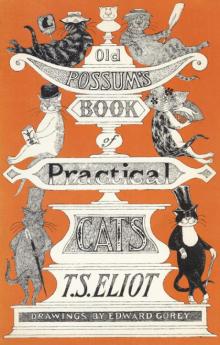 Old Possum's Book of Practical Cats
Old Possum's Book of Practical Cats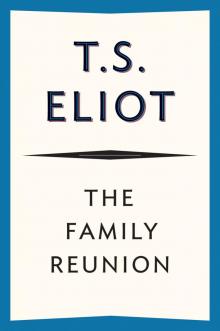 The Family Reunion
The Family Reunion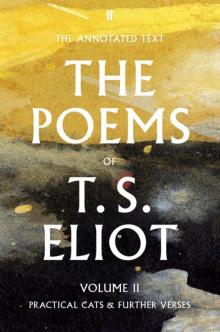 T. S. Eliot the Poems, Volume 2
T. S. Eliot the Poems, Volume 2 The Waste Land
The Waste Land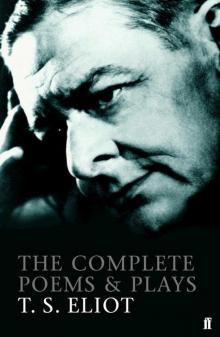 The Complete Poems and Plays, 1909-1950
The Complete Poems and Plays, 1909-1950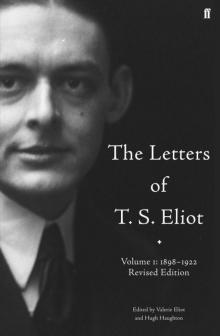 Letters of T.S. Eliot: 1898-1922
Letters of T.S. Eliot: 1898-1922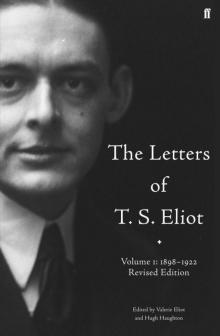 The Letters of T. S. Eliot, Volume 1: 1898-1922
The Letters of T. S. Eliot, Volume 1: 1898-1922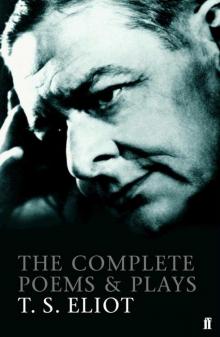 Complete Poems and Plays
Complete Poems and Plays